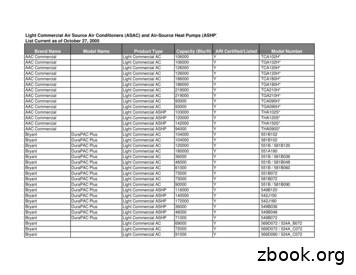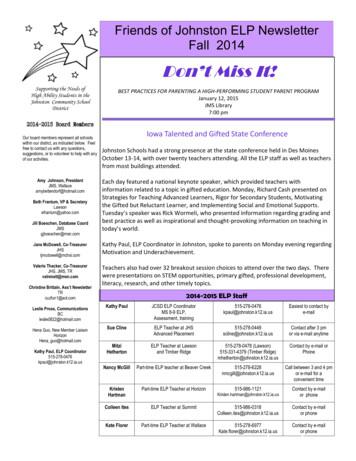Oceanography - Ms. Johnston's Webpage
Oceanography
Oceanography is the scientific study of oceans Oceans make up over 70% of the Earth’s surface An ocean must be large and have features whichset it apart from other oceans (currents, watermasses, submarine boundaries, land masses)
Five Major Oceans1. Pacific Ocean (largest ocean, over 30% of Earth’s surface)2. Atlantic Ocean (2nd largest)3. Indian Ocean (3rd largest, mostly in Southern Hemisphere)4. Arctic Ocean (north pole, smallest ocean)5. Antarctic Ocean (south pole)
The average depth of theoceans is approximately 4Xgreater than the averageelevation of the continents Mt. Everest, the highestpeak on land wouldcompletely disappear in theMarianas Trench, thedeepest place in the ocean
Salinity of Sea Water Salinity is a measure of the dissolved solids in seawater (the main solid is common salt: sodiumchloride) On average 1000 grams of sea water contain 35grams of salts and is written as 35‰ (note that35‰ is also 3.5%)
Areas of low salinity1. Areas where fresh water enters the oceans(mouths of rivers)2. Areas of heavy rainfall (e.g., equator)3. Areas where glaciers enter the oceans
Areas of high salinity1. Hot, dry climates (oceans lose water byevaporation leaving the salts behind). TheMediterranean Sea and the Red Sea can be ashigh as 40‰ (‰ parts per thousand)2. In polar waters near sea ice (when sea waterfreezes, only freshwater ice forms thus saltierwater is left behind)
Why is Salinity Important We can find salinity by evaporating and measuringthe amount of salt left behind A quicker method is to measure the electricalconductivity of the water (the greater the quantityof dissolves salts, the more easily current flows) Salinity is important in identifying water masses :a body of water that has certain properties due toconditions at its place of origin
Composition of Sea Water The percentages shown are the same for all seawater anywhere in the world. The relative amounts of the different dissolvedions do not change even though the salinity doeschange.
Temperature of Ocean Water Oceans don’t heat readily Almost all energy comes from the sun (heat andlight) Most solar radiation is absorbed in the top fewmeters only, thus ocean temperature decreasesquickly with depth
Ocean Temperature Zones: Three Layers Mixed Layer Thermocline Deep Water
Mixed Layer: surface layer where wind and waved mix heat evenlythroughout the zone warm-water layer (2% of oceans volume) Only place where light is present in enough quantityfor plants to grow High latitudes near the equator: this layer is about100 meters deep and 30 C all year Middle latitudes this layer can be 300 meter deep andhave large temperature changes (10 change betweensummer and winter) Near poles this layer may be -2 all year
Thermocline: layer under the mixed layer temperature rapidly drops to about 5 C This layer goes to about 1000 meters deep
Deep Water: Approx 2 C Depth is around 1000 – 4000 meters In the polar areas the oceans are cold throughoutand since cold water is denser it sinks and travelsaway from the polar regions and thus is foundunderneath other ocean water at almost alllatitudes.
Life in the Sea Most in Mixed Layer (sunlight can penetrate)Phytoplankton: microscopic plants basic food source for ocean life (almost all life inthe ocean depend on them) eg. Diatoms able to produce their own food (photosynthesis) Phytoplankton are eaten by Zooplankton whom areeaten by everything from tiny fish to giant whale
Oxygen Almost all living things need oxygen to converttheir food into energy Oxygen comes from either the air mixing withocean water or it is given off by plants living in thewater Therefore, the mixed layer has the most oxygen The deep ocean accumulates carbon dioxide sinceno plants are found here to consume carbondioxide (no photosynthesis)
Ocean Floor Vents (eg. Black Smokers) Some animals can live here (2.5 kmbelow the oceans surface) They don’t require sunlight forenergy or phytoplankton for food Certain bacteria thrive on thehydrogen sulfide produced here andthey become food for larvae andother organisms (barnacles, giantclams, white crabs, giant tubeworms) living near the vents
Ocean FloorThe ocean floor is divided into two major regions1. Continental Margins Continental shelves Continental slope Continental rise2. Ocean Basins
Continental Shelf Part of the continent that is underwater (about 130 m) Extends from the shoreline to the shelf edge An active continental margin: very narrow and borderedby an ocean trench, has coastal mountains along theshoreline (subduction zone) A passive continental margin: broad shelf some can be300km wide, bordered by a coastal plain (seafloorspreading)
Continental Slope Begins at the shelf edge where water depth starts toincrease rapidly (it slopes down toward the deepocean) Changes from continental crust to oceanic crust About 200km wide and 3km deep and has manygullies and small valleys Undersea landslides turbidity currents (powerfulcurrent of mud and sand with water, causing erosion) Gigantic gully submarine canyon
Continental Rise Gently sloping region between the continental slopeand the ocean basin Deposition of sediment several kilometers thick Only found at passive continental margins Can be up to 1000km wide with a very gentle slope
Ocean BasinsFeatures of the floor of the deep sea include Abyssal plainsAbyssal hillsSeamountsGuyotsCoral AtollsTrenchesMid-Ocean RidgesFracture Zones
Abyssal Plains 3000-6000m deep They are so flat that they are the flattest areas onthe Earth’s surface Made of sediments from the continents carried byturbidity currents
Abyssal Hills: small rolling hills, 1-10 km wide and a few hundredmeters highSeamounts: cone-shaped mountain peaks, volcanic in origin andseem to be related to plate boundary activity (and/or hot spots)Guyots: look like seamounts with their tops sliced off (flattopped seamounts), tops were originally above sealevel but removed by wave action (erosion)
Atolls: ring shaped coral islands Begins to form when a coral reef forms around avolcanic island as the seafloor around the island sinks, the coralsinks with it but new corals grow on top of the oldcoral Eventually the volcanic mountain is completelybelow sea level but the circular reef (atoll) is leftwith a central lagoon.
Trench: long narrow steep-sided troughs that runs parallel toeither a continental margin or chains of volcanicislands (almost all in Pacific Ocean) Areas where crust subducts under another plate
Mid-Ocean Ridges: found at divergent plate boundaries, area where newoceanic crust forms as two lithospheric plates moveapart Huge undersea mountain rangese.g. Mid-Atlantic Ridge
Ocean Floor SedimentsFour main classes:1.2.3.4.OozesMuds and ClaysTurbiditesAuthigenic Sediments
1. Oozes: sediments made from microscopic shells Calcareous ooze: contain calcium carbonate Siliceous oozes: contain silicon dioxide2. Muds and Clays: mixtures of fine particles that settle on the oceanfloor May come from land, ash/dust from volcanoes,icebergs
3. Turbidites: deposits made by turbidity currents (these arecurrents that sweep material down the submarinecanyons and out over the abyssal plains) Form graded beds4. Authigenic Sediments: Authigenic (means formed in place) so thesesediments don’t settle on the bottom but formdirectly on the seafloor (eg. Manganese nodules)
Five Major Oceans 1. Pacific Ocean (largest ocean, over 30% of Earth’s surface) 2. Atlantic Ocean (2nd largest) 3. Indian Ocean (3rd largest, mostly in Southern Hemisphere) 4. Arctic Ocean (north pole, smallest ocean) 5. Antarctic Ocean (south pole) The average depth of the
ten.hartman@johnston.k12.ia.us ontact by e-mail or phone Summit 515 -9860318 colleen.ites@johnston.k12.ia.us ontact by email or phone Kate Florer Horizon 515-986-1121 kate.florer@johnston.k12.ia.us ontact by e-mail or phone 2016-2017 ELP Staff Like us on Facebook at Friends of Johnston ELP! Bridget Lagier, 5th grader at Wallace
Fraser-Johnston Light Commercial ASHP 122000 Y *EF-10 & FF-10 Fraser-Johnston Light Commercial ASHP 144000 Y BA-12 Fraser-Johnston Light Commercial ASHP 164000 Y BA-15 Fraser-Johnston Light Commercial ASHP 24400 - 47000 Y BUP024-048 . Brand Name Model Name Product Type Capacity (Btu/H) ARI Certified/Listed Model Number .File Size: 646KB
Kristen.hartman@johnston.k12.ia.us Contact by e-mail or phone Colleen Ites ELP Teacher at Summit 515-986-0318 Colleen.ites@johnston.k12.ia.us Contact by e-mail or phone Kate Florer Part-time ELP Teacher at Wallace 515-278-6977 Kate.florer@johnston.k12.ia.us Contact by e-mail or phone Johnsto
kpaul@johnston.k12.ia.us Easiest to contact by e-mail Sue Cline ELP Teacher at JHS Advanced Placement 515-278-0449 scline@johnston.k12.ia.us Contact after 3 pm or via e-mail anytime Mitzi Hetherton ELP Teacher at Lawson 515-278-0478 (Lawson) 515 -331 4379 (Timber Ridge) mhetherton@johnston.k12.ia.
ten.hartman@johnston.k12.ia.us ontact by e-mail or phone Summit 515 -9860318 colleen.ites@johnston.k12.ia.us ontact by email or phone Kate Florer Horizon 515-986-1121 kate.florer@johnston.k12.ia.us ontact by e-mail or phone 2016-2017 ELP Staff Like us
Director Business & Finance - Johnston CSD Box 10 Johnston , IA 50131 Ph: 515-278-0470 e-mail: jan.millerhook@johnston.k12.ia.us Work Hisory: 2007 to Present Johnston Executive Director of Financial Services 2006 to 2007 Urbandale Director of Business Services 2
Creating a webpage using html James Tam Making A University Webpage Use a simple editor WordPad (dont use MS-Word because it will generate a great deal of extra unnecessary information for a simple webpage). Save it as a text file Make sure you manually add the .htm or .htmlsuffix to the end of the file otherwise it will be text
Create a new webpage using KompoZer Put a blank line between 2 lines in a webpage using the Enter key . Close the index.html webpage (not the whole site) by clicking on the red X in the top right corner of this page. 10.Create another new webpage.























